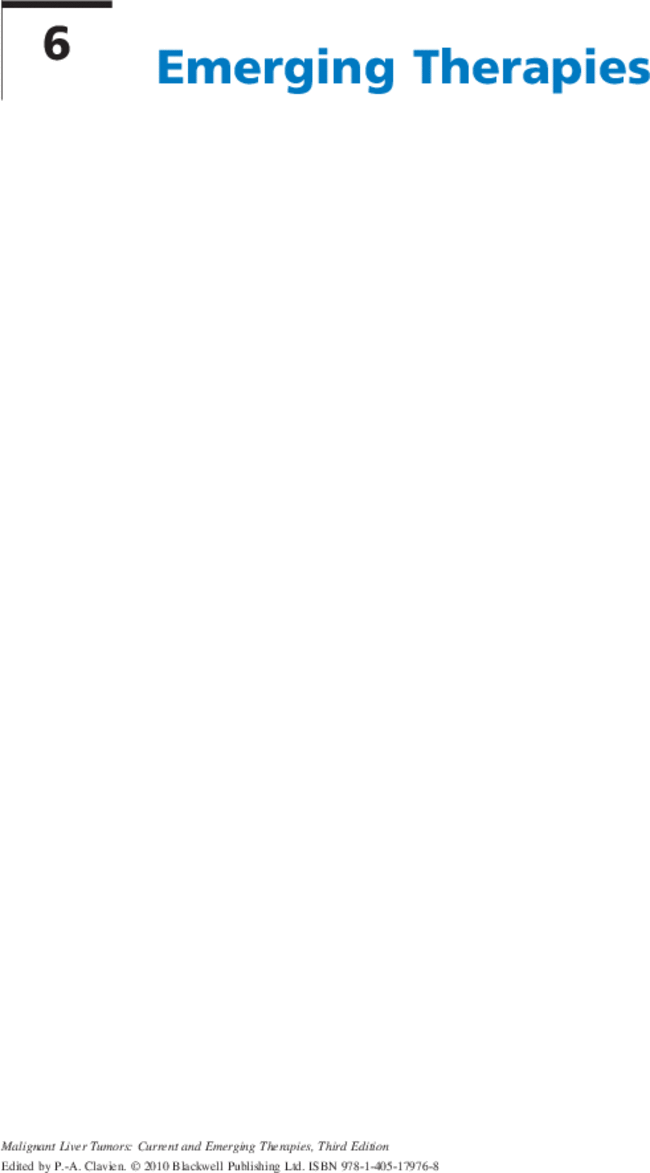Part Introduction
Michael A. Morse MD, MHS
Associate Professor of Medicine
Division of Medical Oncology, Gl Oncology, Molecular Therapeutics Program, Duke University Medical Center, Durham, NC, USA
Search for more papers by this authorJosep M. Llovet MD
Associate Professor of Medicine Professor of Research
Liver Cancer Program, Division of Liver Diseases, Mount Sinai School of Medicine, New York, New York, USA
HCC Translational Research Lab, ICREA, Barcelona-Clinic-Liver-Cancer (BCLC) Group, Institut d' Investigacions Biomèdiques August Pi, i Sunyer (IDIBAPS), Centro de Investigaciones Biomédicas en Red (CIBEREHD), Liver Unit, Hospital Clínic, Barcelona, Spain
Search for more papers by this authorMichael A. Morse MD, MHS
Associate Professor of Medicine
Division of Medical Oncology, Gl Oncology, Molecular Therapeutics Program, Duke University Medical Center, Durham, NC, USA
Search for more papers by this authorJosep M. Llovet MD
Associate Professor of Medicine Professor of Research
Liver Cancer Program, Division of Liver Diseases, Mount Sinai School of Medicine, New York, New York, USA
HCC Translational Research Lab, ICREA, Barcelona-Clinic-Liver-Cancer (BCLC) Group, Institut d' Investigacions Biomèdiques August Pi, i Sunyer (IDIBAPS), Centro de Investigaciones Biomédicas en Red (CIBEREHD), Liver Unit, Hospital Clínic, Barcelona, Spain
Search for more papers by this authorPierre-Alain Clavien MD, Phd, FACS, FRCS
Professor Chairman
Department of Surgery, Swiss Hepato-Pancreato-Biliary and Transplantation Center, University Hospital Zurich, Zurich, Switzerland
Search for more papers by this authorStefan Breitenstein MD
Department of Surgery, Swiss Hepato-Pancreato-Biliary and Transplantation Center, University Hospital Zurich, Zurich, Switzerland
Search for more papers by this author
References
- Farazi PA, DePinho RA. Hepatocellular carcinoma pathogenesis: from genes to environment. Nat Rev Cancer 2006; 6: 674–87.
- Llovet JM, Ricci S, Mazzaferro V, et al. SHARP Investigators Study Group. Sorafenib in advanced hepatocellular carcinoma. N Engl J Med 2008; 359: 378–90.
- Llovet JM, Bruix J. Molecular targeted therapies in hepatocellular carcinoma. Hepatology 2008; 48: 1312–27.
- Pang R, Poon RT. Angiogenesis and antiangiogenic therapy in hepatocellular carcinoma. Cancer Lett 2006; 242: 151–67.
- Chiang DY, Villanueva A, Hoshida Y, et al. Focal gains of VEGFA and molecular classifi cation of hepatocellular carcinoma. Cancer Res 2008; 68: 6779–88.
- Liu L, Cao Y, Chen C, et al. Sorafenib blocks the RAF/MEK/ERK pathway, inhibits tumor angiogenesis, and induces tumor cell apoptosis in hepatocellular carcinoma model PLC/PRF/5. Cancer Res 2006; 66: 11851–8.
- Siegel AB, Cohen EI, Ocean A, et al. Phase II trial evaluating the clinical and biologic effects of bevacizumab in unresectable hepatocellular carcinoma. J Clin Oncol 2008; 26: 2992–8.
- Kiss A, Wang NJ, Xie JP, Thorgeirsson SS. Analysis of transforming growth factor (TGF)-alpha/epidermal growth factor receptor, hepatocyte growth factor/c-met,TGF-beta receptor type II, and p53 expression in human hepatocellular carcinomas. Clin Cancer Res 1997; 3: 1059–1066.
- Ramanathan RK, Belani CP, Singh DA, et al. Phase II study of lapatinib, a dual inhibitor of epidermal growth factor receptor (EGFR) tyrosine kinase 1 and 2 (Her2/Neu) in patients (pts) with advanced biliary tree cancer (BTC) or hepatocellular cancer (HCC). A California Consortium (CCC-P) Trial. J Clin Oncol 2006; 24 (Suppl 18): a4010.
- Zhu AX, Stuart K, Blaszkowsky LS, et al. Phase 2 study of cetuximab in patients with advanced hepatocellular carcinoma. Cancer 2007; 110: 581–9.
- Nam SW, Lee JH, Noh JH, et al. Comparative analysis of expression profiling of early-stage carcinogenesis using nodule-in-nodule-type hepatocellular carcinoma. Eur J Gastroenterol Hepatol 2006; 18: 239–47.
- Okamoto M, Utsunomiya T, Wakiyama S, et al. Specifi c gene-expression profiles of noncancerous liver tissue predict the risk for multicentric occurrence of hepatocellular carcinoma in hepatitis C virus-positive patients. Ann Surg Oncol 2006; 13: 947–54.
- Budhu AS, Zipser B, Forgues M, et al. The molecular signature of metastases of human hepatocellular carcinoma. Oncology 2005; 69 (Suppl 1): 23–7.
- Lee JS, Thorgeirsson SS. Genome-scale profiling of gene expression in hepatocellular carcinoma: classifi cation, survival prediction, and identification of therapeutic targets. Gastroenterology 2004; 127: S51–S55
- Iizuka N, Oka M, Yamada-Okabe H, et al. Comparison of gene expression profiles between hepatitis B virus-and hepatitis C Introduction virus-infected hepatocellular carcinoma by oligonucleotide microarray data on the basis of a supervised learning method. Cancer Res 2002; 62: 3939–44.
- Höpfner M, Huether A, Sutter AP, et al. Blockade of IGF-1 receptor tyrosine kinase has antineoplastic effects in hepatocellular carcinoma cells. Biochem Pharmacol 2006; 71: 1435–48.
- Lee JS, Chu IS, Mikaelyan A, et al. Application of comparative functional genomics to identify best-fit mouse models to study human cancer. Nat Genet 2004; 36: 1306–11.
- Llovet JM, Di Bisceglie A, Bruix J, Kramer B, Lencioni R, Zhu A, Sherman M, Schwartz M, Lotze M, Talwalkar J, and Gores GJ on behalf of Panel of Experts in HCC. Design and end-points of clinical trials in HCC. J Natl Cancer Inst 2008; 100: 698–711.



